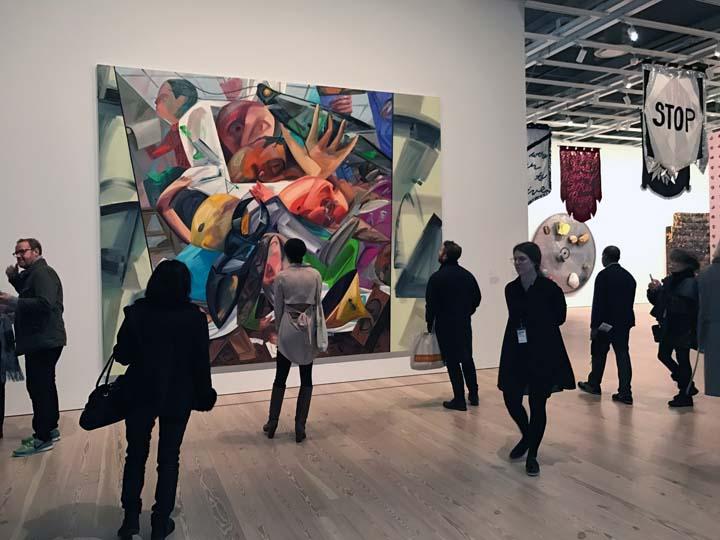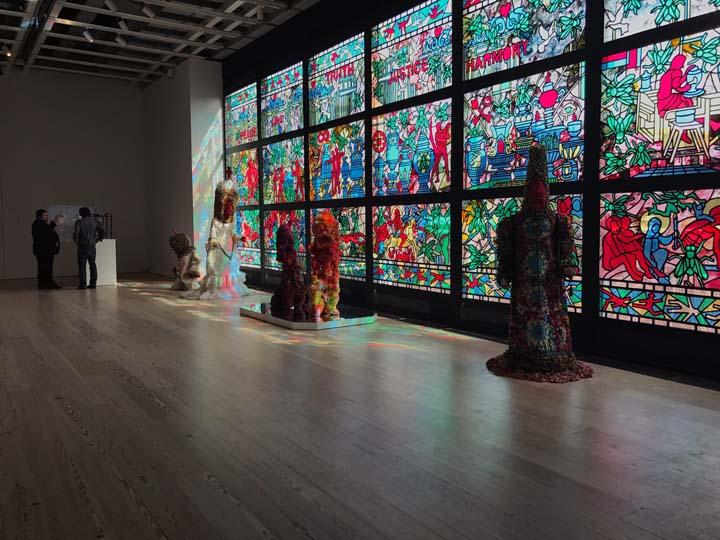The Whitney Biennial 2017
The Whitney Biennial, delayed a year due to the museum’s new construction, opens today. By all accounts from those who attended the preview earlier this week, it was worth waiting for. Luckily so, for the opening gala and members’ previews of the 78th installment of the longest-running survey of American art were cancelled due to the Nor’easter that blasted in on Monday night. Above: photo © Ed Lederman, courtesy the Whitney Museum of American Art.
Installed across the fifth and sixth floors of the Renzo Piano-designed building that opened two years ago, curators Christopher Y. Lew and Mia Locks have selected works large enough—both in scale and in impact—to rise to the surroundings. Unlike past iterations of the always-anticipated view of contemporary art, crammed to excess into the comparatively modest spaces of the Breuer building, the 2017 version seems settled, even established, in its expansive new quarters. With 63 artists, partners and collectives, fewer than before, there’s a lot to see and room for viewing.

All mediums get their due here, with a painting by Dana Schutz opposite the fifth floor elevator (above) an introduction to what follows in that discipline. Works by Henry Taylor, Shara Hughes, and Carrie Moyer, to name a few, return brushy strokes on canvas to the forefront in both figural and abstract endeavors.
Installation—the now sculpture, and furniture—the new installation, are dominant, large and impressive. The political turmoil of the past year emerges, literally and metaphorically across works in sculpture and installation and in painting as well. From the opening view on the fifth floor, Cauleen Smith’s ceiling-mounted banners, heraldic exhortations to stop the violence, introduce a group of installations, bordered on the left by Occupy Museums’ Debtfair, John Kessler’s Exodus (bottom), and on the right by William Pope L’s Claim. Here, racially charged content meets social and environmental decay head on, with Claim, in which putrifying bologna stapled to a large pastel cabin, provokes high anxiety while it calculatingly undermines the power of “big data” to quantify social progress (it's nothing but baloney).
While many of the artists represented were born since 1980, the curators have also reached to past masters including John Divola, Jo Baer and Larry Bell, who for this viewer offer a historical view that now is better—when captured by genius. Proven by the massive sixth floor installation by Raul de Nieves, in which he covers the 30-foot-high windows with a “stained glass” backdrop for an installation of mannequins cloaked in elaborately beaded costumes used by the artist in his performances, along with a few more abstract characters (above). According to the wall text, the windows, emblazoned with the words “Peace,” “Hope,” “Justice,” symbolize a world in which death and waste are omnipresent; however de Nieves presents death as a metaphor for a spectacular transformation and rebirth in an unpredictable and turbulent world.
Nieves’s preoccupations are mirrored on the fifth floor, by Asad Raza’s Root sequence. Mother tongue. Here, 26 trees [two each of 13 species, according to the artist] bring a forest environment, complete with captured aromas, into the museum. The artist said that he hopes to create a respite from the tasks of viewing, judgment and critique that usually makes for a museum experience. Raza has invited a series of guests to occupy the installation with musical, dance and intellectual events for weekend visitors.

Video—for which the Whitney can perhaps be single-handedly credited with ushering into the museum of the present—is generously represented in solo galleries off the main spaces. With a mere three hours to preview this expansive show, however, the videos will have to wait for a future issue of DART.
The Whitney Biennial 2017 continues through June 11th. The Whitney Museum of American Art, 99 Gansevoort Street, NY, NY Info Photos, except as noted: © Peggy Roalf




